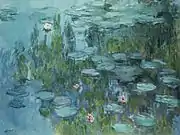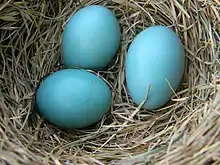Cyan
Cyan (/ˈsaɪ.ən/, /ˈsaɪˌæn/)[1][2][3] is a greenish-blue color.[4][5] It is evoked by light with a predominant wavelength of between 490 and 520 nm, between the wavelengths of green and blue.[6]
| Cyan | |
|---|---|
  _with_Dog_and_Dragon_LACMA_53.41.3a-b_(cropped).jpg.webp)  .jpg.webp) .jpg.webp) | |
| Spectral coordinates | |
| Wavelength | 490–520 nm |
| Frequency | 610–575 THz |
| Common connotations | |
| water | |
| Hex triplet | #00FFFF |
| HSV (h, s, v) | (180°, 100%, 100%) |
| sRGBB (r, g, b) | (0, 255, 255) |
| Source | CSS Color Module Level 3 |
| B: Normalized to [0–255] (byte) H: Normalized to [0–100] (hundred) | |
In the subtractive color system, or CMYK color model, which can be overlaid to produce all colors in paint and color printing, cyan is one of the primary colors, along with magenta, yellow, and black. In the additive color system, or RGB color model, used to create all the colors on a computer or television display, cyan is made by mixing equal amounts of green and blue light. Cyan is the complement of red; it can be made by the removal of red from white light. Mixing red light and cyan light at the right intensity will make white light.
The web color cyan is synonymous with aqua. Other colors in the cyan color range are teal, turquoise, electric blue, aquamarine, and others described as blue-green.
Gallery
 In the RGB color model, used to make colors on computer and TV displays, cyan is created by the combination of green and blue light.
In the RGB color model, used to make colors on computer and TV displays, cyan is created by the combination of green and blue light. In the RGB color wheel of additive colors, cyan is midway between blue and green.
In the RGB color wheel of additive colors, cyan is midway between blue and green. In the CMYK color model, used in color printing, cyan, magenta and yellow combined make black. In practice, since the inks are not perfect, some black ink is added.
In the CMYK color model, used in color printing, cyan, magenta and yellow combined make black. In practice, since the inks are not perfect, some black ink is added. Color printers today use magenta, cyan, and yellow ink to produce the full range of colors.
Color printers today use magenta, cyan, and yellow ink to produce the full range of colors. Cyan and red are complementary colors. They have strong contrast and harmony, and if combined, they make either white, black or grey, depending upon the color system used.
Cyan and red are complementary colors. They have strong contrast and harmony, and if combined, they make either white, black or grey, depending upon the color system used. Cyan is the color of shallow water over a sandy beach. The water absorbs the color red from the sunlight, leaving a greenish-blue color.
Cyan is the color of shallow water over a sandy beach. The water absorbs the color red from the sunlight, leaving a greenish-blue color. The dome of the Tilla Kari Mosque in Samarkand, Uzbekistan (1660) is cyan. The color is widely used in architecture in Turkey and Central Asia.
The dome of the Tilla Kari Mosque in Samarkand, Uzbekistan (1660) is cyan. The color is widely used in architecture in Turkey and Central Asia.
 A surgical team in Germany. It has been suggested that surgeons and nurses adopted a cyan-colored gown and operating rooms because it is complementary to the color of red blood and thus reduced glare,[7] though the evidence for this claim is limited.
A surgical team in Germany. It has been suggested that surgeons and nurses adopted a cyan-colored gown and operating rooms because it is complementary to the color of red blood and thus reduced glare,[7] though the evidence for this claim is limited.
Etymology
Its name is derived from the Ancient Greek κύανος, transliterated kyanos, meaning "dark blue, dark blue enamel, Lapis lazuli".[8][9] It was formerly known as "cyan blue"[10] or cyan-blue,[11] and its first recorded use as a color name in English was in 1879.[12] Further origins of the color name can be traced back to a dye produced from the cornflower (Centaurea cyanus).[13][14]
In most languages, 'cyan' is not a basic color term and it phenomenologically appears as a greenish vibrant hue of blue to most English speakers. Other English terms for this "borderline" hue region include blue green, aqua, and turquoise.[15]
Cyan on the web and in printing
The web colors cyan and aqua
| Cyan (additive secondary) | |
|---|---|
| Hex triplet | #00FFFF |
| HSV (h, s, v) | (180°, 100%, 100%) |
| sRGBB (r, g, b) | (0, 255, 255) |
| Source | X11 |
| ISCC–NBS descriptor | Brilliant bluish green |
| B: Normalized to [0–255] (byte) | |
The web color cyan shown at right is a secondary color in the RGB color model, which uses combinations of red, green and blue light to create all the colors on computer and television displays. In X11 colors, this color is called both cyan and aqua. In the HTML color list, this same color is called aqua.
The web colors are more vivid than the cyan used in the CMYK color system, and the web colors cannot be accurately reproduced on a printed page. To reproduce the web color cyan in inks, it is necessary to add some white ink to the printer's cyan below, so when it is reproduced in printing, it is not a primary subtractive color. It is called aqua (a name in use since 1598) because it is a color commonly associated with water, such as the appearance of the water at a tropical beach.[16]
Process cyan
| Cyan (subtractive primary) | |
|---|---|
| Hex triplet | #00B7EB |
| HSV (h, s, v) | (193°, 100%, 92[17]%) |
| sRGBB (r, g, b) | (0, 183, 235) |
| Source | CMYK[18] |
| ISCC–NBS descriptor | Brilliant greenish blue |
| B: Normalized to [0–255] (byte) H: Normalized to [0–100] (hundred) | |
Cyan is also one of the common inks used in four-color printing, along with magenta, yellow, and black; this set of colors is referred to as CMYK. In printing, the cyan ink is sometimes known as printer's cyan, process cyan, or process blue.
While both the additive secondary and the subtractive primary are called cyan, they can be substantially different from one another. Cyan printing ink is typically more saturated than the RGB secondary cyan, depending on what RGB color space and ink are considered. That is, process cyan is usually outside the RGB gamut,[19] and there is no fixed conversion from CMYK primaries to RGB. Different formulations are used for printer's ink, so there can be variations in the printed color that is pure cyan ink. This is because real-world subtractive (unlike additive) color mixing does not consistently produce the same result when mixing apparently identical colors, since the specific frequencies filtered out to produce that color affect how it interacts with other colors. Phthalocyanine blue is one such commonly used pigment. A typical formulation of process cyan is shown in the color box at right.
In science and nature
Color of water
- Pure water is nearly colorless. However, it does absorb slightly more red light than blue, giving large volumes of water a bluish tint; increased scattering of blue light due to fine particles in the water shifts the blue color toward green, for a typically cyan net color.[20]
Cyan and cyanide
- Cyanide derives its name from Prussian blue, a blue pigment containing the cyanide ion.[21]
Bacteria
- Cyanobacteria (sometimes called blue-green algae) are an important link in the food chain.[22]
Astronomy
- The planet Uranus is colored cyan because of the abundance of methane in its atmosphere. Methane absorbs red light and reflects the blue-green light which allows observers to see it as cyan.[23]
Energy
- Natural gas (methane), used by many for home cooking on gas stoves, has a cyan colored flame when burned with a mixture of air.[24]
Photography and film
- Cyanotype, or blueprint, a monochrome photographic printing process that predates the use of the word cyan as a color, yields a deep cyan-blue colored print based on the Prussian blue pigment.[25]
- Cinecolor, a bi-pack color process, the photographer would load a standard camera with two films, one orthochromatic, dyed red, and a panchromatic strip behind it. Color light would expose the cyan record on the ortho stock, which also acted as a filter, exposing only red light to the panchromatic film stock.[26][27]
See also
| Wikimedia Commons has media related to Cyan. |
References
- "cyan". Oxford English Dictionary (Online ed.). Oxford University Press. (Subscription or participating institution membership required.)
- "Cyan definition on dictionary.com". Dictionary.com. Retrieved 30 September 2014.
- "cyan". The American Heritage Dictionary of the English Language (5th ed.). Boston: Houghton Mifflin Harcourt.
- "Cyan - Definition and More from the Free Merriam-Webster Dictionary". Retrieved 30 September 2014.
- Shorter Oxford English Dictionary, 5th Edition, Oxford University Press, 2002.
- Andrew Zimmerman Jones. "Visible Light Spectrum - Overview and Chart". About.com. Retrieved 30 September 2014.
- Belkin (March–April 1998). "Surgical scrubs--where we were, where we are going". Todays Surg Nurse. 20 (2): 28–34. PMID 10026627.
- "Online Etymology Dictionary". Retrieved 30 September 2014.
- "Henry George Liddell, Robert Scott, A Greek-English Lexicon, κύα^νος". Retrieved 30 September 2014.
- J. Arthur H. Hatt (1908). The Colorist: Designed to Correct the Commonly Held Theory that Red, Yellow, and Blue are the Primary Colors and to Supply the Much Needed Easy Method of Determining Color Harmony. D. Van Nostrand Company. p. 22.
- Shorter Oxford English Dictionary, 5th edition.
- Maerz and Paul A Dictionary of Color New York:1930 McGraw-Hill page 194
- The Pigment Compendium: A Dictionary of Historical Pigments, Nicholas Eastaugh, Valentine Walsh, Tracey Chaplin, Ruth Siddall, 2004, Routledge, ISBN 9781136373855
- Eastaugh, Nicholas; Walsh, Valentine; Chaplin, Tracey; Siddall, Ruth (30 March 2007). Pigment Compendium: A Dictionary of Historical Pigments. ISBN 9781136373855. Retrieved 30 September 2014.
- Raffman, Diana (2014). Unruly Words: A Study of Vague Language. OUP USA. pp. 56–57. ISBN 9780199915101. Retrieved 31 July 2019.
- Maerz and Paul The Dictionary of Color 1930 (see under Aqua in Index, page 189)
- Using HSL color space#Conversion from RGB to HSL or HSV, v=247/255
- "tintbook.com". Archived from the original on 10 March 2007. Retrieved 30 September 2014.
- P.U.P.A. Gilbert and Willy Haeberli (2011). Physics in the Arts (Revised ed.). Academic Press. p. 110. ISBN 9780123918895. Retrieved 31 July 2019.CS1 maint: uses authors parameter (link)
- Craig F. Bohren (2001). Clouds in a Glass of Beer: Simple Experiments in Atmospheric Physics. Courier Dover Publications. ISBN 0-486-41738-7.
- Best, Janet (2017-06-08). Colour Design: Theories and Applications. Woodhead Publishing. ISBN 9780081018897.
- Elaine, McKeown, A. (2015-10-27). Impact of Water Pollution on Human Health and Environmental Sustainability. IGI Global. ISBN 9781466695603.
- Administrator, NASA Content (2015-04-02). "Uranus in True and False Color". NASA. Retrieved 2017-09-28.
- Hahn, Eric. "Gas Flame Colour Temperature Chart (Yellow Flame vs Blue Flame)". ELGAS - LPG Gas for Home & Business. Retrieved 2017-11-10.
- Mike Ware (1999). Cyanotype: the history, science and art of photographic printing in Prussian blue. NMSI Trading Ltd. ISBN 1-900747-07-3.
- Belton, John (2000): CinecoIor. In: Film History, 12,4, Color Film (2000), pp. 344-357.
- "Cinecolor". widescreenmuseum.com. Retrieved 2017-11-10.
- Mosby's Medical, Nursing & Allied Health Dictionary. Mosby-Year Book (4th ed.). 1994. p. 425.
